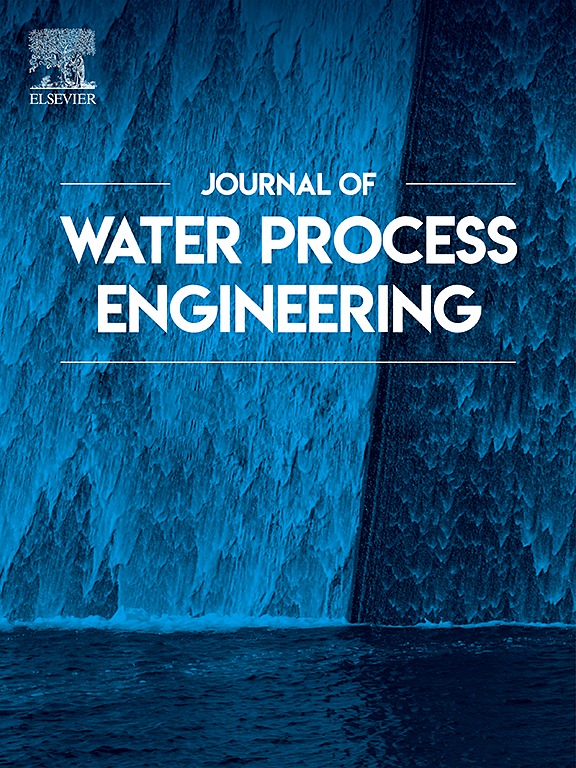Fenton和太阳光-Fenton氧化法去除洗土合成乳剂中的蒽和苯并[a]芘
IF 6.3
2区 工程技术
Q1 ENGINEERING, CHEMICAL
引用次数: 0
摘要
本研究考察了在水处理应用中使用Fenton和太阳光-Fenton氧化去除污染物和回收表面活性剂的多环芳烃(PAHs)水乳液的处理,相当于从土壤洗涤中获得的水乳液。多环芳烃是工业废水中的持久性污染物,需要可持续的处理方法。土壤被蒽(ANT)和苯并[a]芘(BaP)污染,用十二烷基硫酸钠(SDS)以2:1的质量液土比洗涤,SDS浓度范围为2500 ~ 10,000 mg L−1。制备了SDS: 4500mg L−1,ANT: 5mg L−1,BaP: 5mg L−1的合成乳液,并采用低氧化剂(h2o₂:60 ~ 240mg L−1)和催化剂(Fe: 2.5 ~ 10mg L−1)进行处理,以优化试剂用量。Fenton工艺(pH = 3)可以完全去除PAHs,在所有条件下BaP都可以完全降解,ANT需要更高的氧化剂(H₂O₂,240 mg L−1)和催化剂(Fe, 10 mg L−1)浓度。在接近中性的pH下,使用草酸铁络合物(120 mg L−1 H2O2, 10 mg L−1 Fe),太阳能光- fenton工艺可以去除高达70%的ANT和85%的BaP。最小的SDS降解和微不足道的矿化支持表面活性剂的回收和再利用,提高工艺的可持续性。这些发现强调了光辅助高级氧化工艺在工程水系统中选择性降解污染物的可行性,支持了成本效益和环境友好型修复技术的发展。本文章由计算机程序翻译,如有差异,请以英文原文为准。
Removal of antracene and benzo[a]pyrene from soil-washing synthetic emulsions by Fenton and solar photo-Fenton oxidation
This study examines the treatment of polycyclic aromatic hydrocarbons (PAHs) aqueous emulsions, equivalent to those obtained from soil-washing, using Fenton and solar photo-Fenton oxidation for pollutant removal and surfactant recovery in water treatment applications. PAHs, persistent contaminants in industrial wastewater, require sustainable treatment approaches. Soil was contaminated with anthracene (ANT) and benzo[a]pyrene (BaP) and washed with sodium dodecyl sulfate (SDS) at a mass liquid-to-soil ratio of 2:1, with SDS concentrations ranging from 2500 to 10,000 mg L−1. A synthetic emulsion (SDS: 4500 mg L−1, ANT: 5 mg L−1, BaP: 5 mg L−1) was prepared and treated using low oxidant (H₂O₂: 60–240 mg L−1) and catalyst (Fe: 2.5–10 mg L−1) dosages to optimize reagent consumption. The Fenton process (pH = 3) achieved complete PAHs removal, with BaP fully degraded under all conditions and ANT requiring higher oxidant (H₂O₂, 240 mg L−1) and catalyst (Fe, 10 mg L−1) concentrations. The solar photo-Fenton process achieved up to 70 % ANT and 85 % BaP removal at near-neutral pH using ferrioxalate complexes (120 mg L−1 H2O2, 10 mg L−1 Fe). Minimal SDS degradation and negligible mineralization support surfactant recovery and reuse, enhancing process sustainability. These findings highlight the viability of light-assisted advanced oxidation processes for selective pollutant degradation in engineered water systems, supporting the development of cost-effective and environmentally friendly remediation technologies.
求助全文
通过发布文献求助,成功后即可免费获取论文全文。
去求助
来源期刊

Journal of water process engineering
Biochemistry, Genetics and Molecular Biology-Biotechnology
CiteScore
10.70
自引率
8.60%
发文量
846
审稿时长
24 days
期刊介绍:
The Journal of Water Process Engineering aims to publish refereed, high-quality research papers with significant novelty and impact in all areas of the engineering of water and wastewater processing . Papers on advanced and novel treatment processes and technologies are particularly welcome. The Journal considers papers in areas such as nanotechnology and biotechnology applications in water, novel oxidation and separation processes, membrane processes (except those for desalination) , catalytic processes for the removal of water contaminants, sustainable processes, water reuse and recycling, water use and wastewater minimization, integrated/hybrid technology, process modeling of water treatment and novel treatment processes. Submissions on the subject of adsorbents, including standard measurements of adsorption kinetics and equilibrium will only be considered if there is a genuine case for novelty and contribution, for example highly novel, sustainable adsorbents and their use: papers on activated carbon-type materials derived from natural matter, or surfactant-modified clays and related minerals, would not fulfil this criterion. The Journal particularly welcomes contributions involving environmentally, economically and socially sustainable technology for water treatment, including those which are energy-efficient, with minimal or no chemical consumption, and capable of water recycling and reuse that minimizes the direct disposal of wastewater to the aquatic environment. Papers that describe novel ideas for solving issues related to water quality and availability are also welcome, as are those that show the transfer of techniques from other disciplines. The Journal will consider papers dealing with processes for various water matrices including drinking water (except desalination), domestic, urban and industrial wastewaters, in addition to their residues. It is expected that the journal will be of particular relevance to chemical and process engineers working in the field. The Journal welcomes Full Text papers, Short Communications, State-of-the-Art Reviews and Letters to Editors and Case Studies
 求助内容:
求助内容: 应助结果提醒方式:
应助结果提醒方式:


